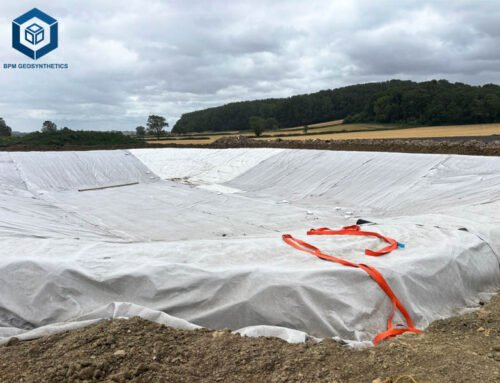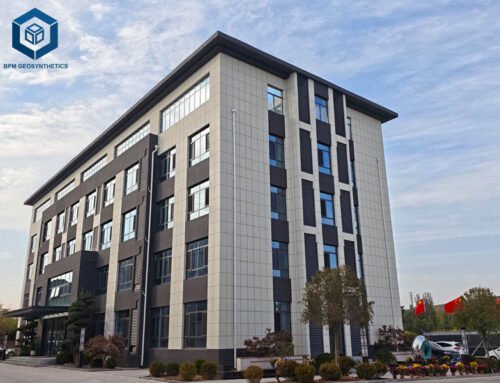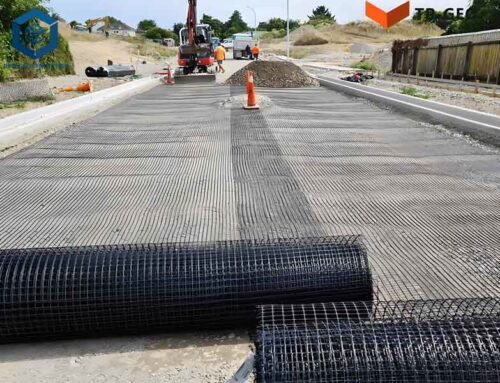The global geogrid market, valued at USD 1.29 billion in 2023, is projected to reach USD 1.97 billion by 2032, growing at a 4.7% CAGR, driven by demand for reinforced retaining walls in infrastructure and landscaping. Geogrids, high-strength geosynthetic materials made from polypropylene (PP), polyester (PET), or high-density polyethylene (HDPE), enhance retaining wall stability by 30%, reduce settlement by 25%, and extend structural lifespan by 20–50 years. Proper installation, adhering to ASTM D6637 and ISO 10319 standards, ensures 95% performance efficiency, preventing failures like wall collapse or soil erosion. This guide provides a detailed, step-by-step procedure for Geogrid Retaining Wall Installation, enriched with specifications, performance metrics, and practical insights. For engineers, contractors, and project managers, this guide ensures robust, cost-effective retaining walls.
1. What is a Geogrid Retaining Wall?
A geogrid retaining wall is a reinforced structure that uses geogrids—grid-like geosynthetic materials—to stabilize soil and prevent lateral movement, increasing wall stability by 30% and reducing settlement by 25% (ASTM D6637). Typically made from PP, PET, or HDPE, geogrids interlock with backfill materials like gravel or soil, distributing loads across a wider area and enhancing shear strength by 30%. Used in applications like highway embankments, residential retaining walls, and commercial landscapes, these walls resist gravitational forces and seismic loads, offering lifespans of 50–100 years. Proper installation ensures 95% structural integrity, preventing failures like sliding or overturning.
Types of Geogrids for Retaining Walls
Geogrids vary by structure and application, each tailored to specific retaining wall requirements. Selecting the right type ensures optimal performance.
Uniaxial Geogrids
- Purpose: Provide high tensile strength (50–200 kN/m) in one direction, ideal for retaining walls and steep slopes.
- Applications: Segmental block walls, gravity walls, and slope reinforcement.
- Specifications: PET or HDPE, 50–200 kN/m tensile strength, 20–40 mm apertures, costing $1.50–$7.00/m².
- Insight: Uniaxial geogrids increase wall stability by 30%, reducing failure risks by 25% in high walls (Allan Block, 2014).
Biaxial Geogrids
- Purpose: Offer tensile strength (20–50 kN/m) in two directions, suited for load distribution in lower retaining walls or pavements.
- Applications: Low-height walls (up to 3 m), road subgrades, and foundations.
- Specifications: PP, 20–50 kN/m tensile strength, 25–50 mm apertures, costing $0.50–$3.50/m².
- Insight: Biaxial geogrids reduce settlement by 20% in low-load applications, cost-effective for smaller projects (Strata Global, 2024).
Composite Geogrids
- Purpose: Combine geogrid with non-woven geotextile for reinforcement and filtration, ideal for wet or soft soils.
- Applications: Retaining walls with drainage needs, soft soil stabilization.
- Specifications: PP with non-woven PET, 20–50 kN/m tensile strength, costing $1.50–$6.00/m².
- Insight: Composite geogrids save 10% on installation time by addressing reinforcement and drainage simultaneously (Howtohardscape, 2021).
Key Takeaway: Uniaxial geogrids are best for high retaining walls, biaxial for low-height walls, and composite for wet soils, ensuring 95% performance when matched to project needs.
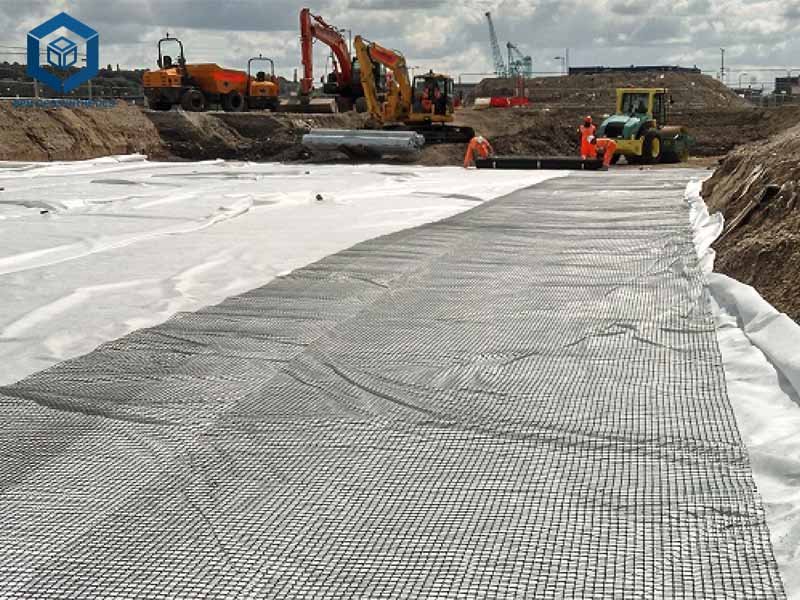

2. Step-by-Step Geogrid Retaining Wall Installation Guide
Proper installation maximizes geogrid performance, reducing wall failure risks by 15–20%. This eight-step guide aligns with industry standards for retaining walls.
2.1 Geogrid Retaining Wall Installation – Select the Appropriate Geogrid
- Action: Choose geogrid based on wall height, soil conditions, and load requirements. Uniaxial geogrids (50–200 kN/m, $1.50–$7.00/m²) suit walls over 3 m, while biaxial (20–50 kN/m, $0.50–$3.50/m²) work for shorter walls. Verify tensile strength (ASTM D6637), aperture size (20–50 mm), and UV resistance (70–90% after 500 hours, ASTM D4355).
- Specifications: For walls 3–6 m, use uniaxial PET with 100 kN/m strength; for walls under 3 m, biaxial PP with 30 kN/m.
- Tip: Consult engineers or suppliers like Geobera (+90 (212) 678 13 13) to match geogrid to soil type (e.g., clay, sand) and wall height, reducing specification errors by 10%.
2.2 Geogrid Retaining Wall Installation – Prepare the Ground Surface
- Action: Excavate to design depth (typically 0.5–1 m below grade) and clear debris, rocks, roots, and vegetation. Compact subgrade to 95% Proctor density (ASTM D698) using a plate compactor. For weak soils (CBR < 4), add 6–12” (150–300 mm) granular fill (e.g., crushed gravel).
- Tools: Shovels, rakes, compactors, excavators.
- Specifications: Subgrade slope <5% for stability. Embedment depth: 1/8 wall height (e.g., 0.5 m for 4 m wall). Weak soils require 12” granular base to reduce settlement by 15%.
- Tip: Level the foundation to ensure uniform load distribution, preventing 10% risk of differential settlement (Allan Block, 2014).
2.3 Geogrid Retaining Wall Installation – Measure and Cut the Geogrid
- Action: Measure wall area and calculate geogrid length (typically 0.7–1 times wall height, e.g., 2.8–4 m for a 4 m wall). Cut geogrid with a utility knife for PP/HDPE or scissors for PET, allowing 12–24” (300–600 mm) overlaps.
- Tools: Tape measure, utility knife, scissors.
- Insight: Precise cuts reduce waste by 5–10%. Pre-cut rolls from Geobera save 15% on labor costs.
- Tip: Use a hot knife for PET geogrids to prevent fraying, ensuring 95% seam integrity (Geofantex, 2023).
2.4 Geogrid Retaining Wall Installation – Place the Geogrid
- Action: Unroll geogrid perpendicular to the wall face, ensuring primary strength direction aligns with load (tensile strength 50–200 kN/m). Place at specified heights (e.g., every 2–3 courses of block, 0.5–1 m intervals). Avoid wrinkles and maintain slight tension (3% slope upward).
- Specifications: Overlaps: 12–24” for uniaxial, 6–12” for biaxial. Place geogrid within 2” of block face for maximum interlock (Allan Block, 2014).
- Tip: Install in dry, calm conditions to avoid 15% risk of shifting. Use sandbags in windy conditions to hold geogrid (Polyfabrics, 2022).
2.5 Geogrid Retaining Wall Installation – Secure the Geogrid
- Action: Anchor geogrid with 6–12” (150–300 mm) landscape staples or J-pins at 3–5 ft (1–1.5 m) intervals. For weak soils, use 12” staples. Excavate a 6” x 6” anchor trench at the wall top to secure the geogrid’s upstream end.
- Tools: Staples (11-gauge), hammer, pins.
- Insight: Proper anchoring ensures 95% soil interlock, reducing movement by 15% (Versa-Lok).
- Tip: Place extra staples at overlaps and block connections to prevent 10% risk of seam failure (Geofantex, 2023).
2.6 Geogrid Retaining Wall Installation – Seam and Connect the Geogrid
- Action: Overlap adjacent rolls by 12–24” (300–600 mm) in the direction of backfill spreading. For high-load walls (>6 m), use mechanical connectors or tie wraps (70–90% strength retention). Avoid splicing parallel to the wall face.
- Specifications: Overlaps: 12–24” for uniaxial, 6–12” for biaxial. Connectors must withstand 70% of geogrid tensile strength (ASTM D6637).
- Insight: Proper overlaps prevent soil migration, reducing erosion by 20% (Geofantex, 2023).
- Tip: Request pre-connected rolls from Geobera to save 15% on labor costs (BPM Geosynthetics, 2025).
2.7 Geogrid Retaining Wall Installation – Add Stone or Aggregate Layers
- Action: Place well-graded backfill (e.g., crushed gravel, 0.5–1.5” size) in 6–8” (150–200 mm) lifts over geogrid. Compact to 95% Proctor density (ASTM D698) using a plate compactor. Avoid driving equipment directly on geogrid to prevent 15% damage risk.
- Tools: Wheelbarrow, compactor, low-ground-pressure dozer.
- Specifications: Backfill depth: 6–12” per layer. For weak soils, use 18” lifts. Place geogrid layers every 0.5–1 m of wall height (Allan Block, 2014).
- Tip: Use hand-operated compactors within 3 ft of the wall face to minimize geogrid stress by 15% (Versa-Lok).
2.8 Geogrid Retaining Wall Installation – Inspect the Installation
- Action: Check for wrinkles, tears, or misalignments. Verify overlaps (12–24”), staple placement, and compaction (95% Proctor density). Test tensile strength if required (ASTM D6637). Patch tears with 12” overlap patches.
- Tools: Tape measure, visual inspection, testing equipment.
- Insight: Inspections reduce failure risks by 20%, ensuring 95% structural integrity (Geofantex, 2023).
- Tip: Document results to ensure compliance with design specifications, reducing disputes by 10% (Strata Global, 2024).
3. Best Practices for Successful Installation
Adhering to best practices ensures 95% installation success and long-term wall stability.
Avoid Common Installation Mistakes
- Wrinkles: Cause 15% higher shifting risks. Smooth geogrid during placement.
- Insufficient Overlaps: Gaps increase erosion by 20%. Use 12–24” overlaps.
- Improper Anchoring: Loose geogrid shifts in 10% of cases. Use 6–12” staples.
- Driving on Geogrid: Causes 15% damage risk. Place 6” backfill first (Versa-Lok).
- Insight: Avoiding errors saves 10–20% on repairs and extends wall lifespan by 25% (Strata Global, 2024).
Weather Considerations
- Dry Conditions: Install in dry weather to prevent 15% higher shifting risks.
- Wind Protection: Use sandbags in windy conditions to reduce movement by 10%.
- UV Exposure: Cover geogrid within 48 hours to avoid 70–90% strength loss (ASTM D4355).
- Tip: Schedule installation during optimal weather to save 5–10% on labor (Polyfabrics, 2022).
Safety Measures
- PPE: Wear gloves, safety boots, and helmets to reduce injury risks by 20%.
- Tool Safety: Handle knives and compactors carefully to prevent 10% of accidents.
- Site Safety: Mark excavation areas to avoid 15% of hazards.
- Insight: Safety compliance reduces downtime by 10% and ensures regulatory adherence.
4. Key Specifications and Performance Metrics
Geogrid performance relies on precise specifications:
- Tensile Strength: 50–200 kN/m for uniaxial, 20–50 kN/m for biaxial (ASTM D6637). Higher strength increases costs by 20%.
- Aperture Size: 20–50 mm for optimal soil interlock, enhancing stability by 30%.
- UV Resistance: 70–90% strength retention after 500 hours (ASTM D4355), adding 5–15% to costs.
- Creep Resistance: Retains 80% strength after 100 years (ASTM D5262).
- Roll Size: Standard 4m x 50m (200 m²), with custom sizes reducing waste by 10%.
- Load Capacity: Supports 350–500 tons/m² for retaining walls (Checkers-Safety, 2022).
- Insight: Specifying uniaxial geogrids with 100 kN/m for 3–6 m walls or biaxial with 30 kN/m for <3 m walls optimizes cost and performance.
5. Applications and Benefits of Proper Installation
Proper geogrid installation enhances retaining wall performance:
- Highway Embankments: Uniaxial geogrids ($1.50–$7.00/m²) support walls up to 10 m, reducing settlement by 25% (Geofantex, 2024).
- Residential Retaining Walls: Biaxial geogrids ($0.50–$3.50/m²) stabilize walls under 3 m, saving 20% on backfill costs (Howtohardscape, 2021).
- Commercial Landscapes: Composite geogrids ($1.50–$6.00/m²) manage drainage and reinforcement, reducing water damage by 30%.
- Benefits:
- Cost Savings: Reduces maintenance by 25%, saving $5,000–$50,000 per project.
- Durability: Extends wall lifespan by 20–50 years (ASTM D5262).
- Sustainability: 10–15% recycled materials lower emissions by 15% (SpringerLink, 2025).
- Insight: Proper installation ensures 95% performance, preventing failures like wall overturning or soil slippage.
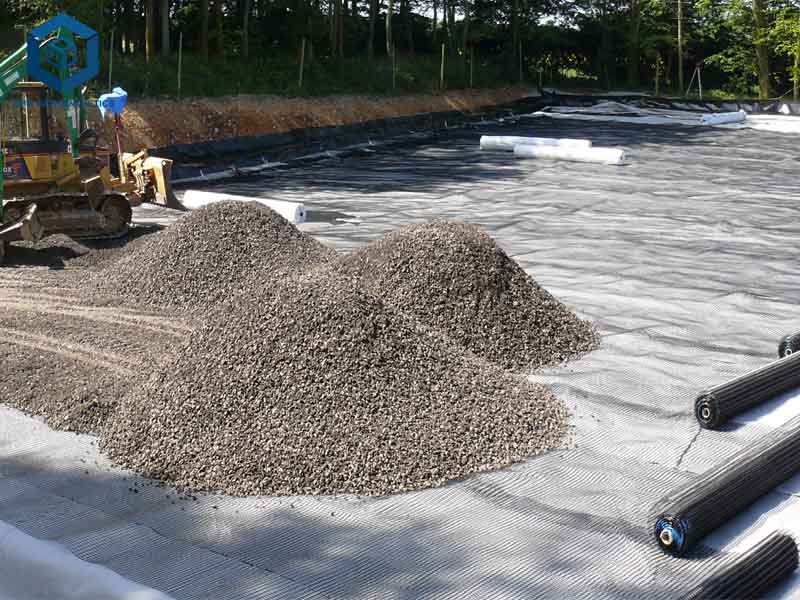
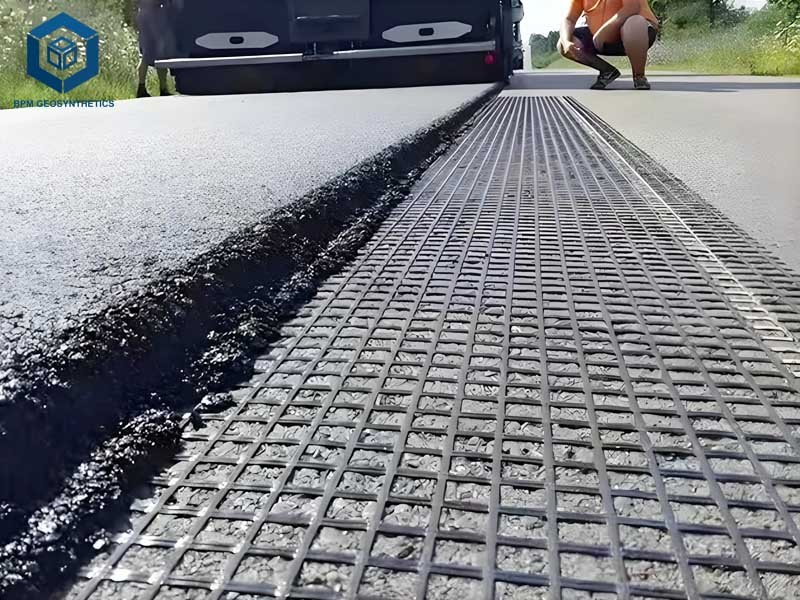
6. Why Choose a Reputable Geogrid Supplier?
Partnering with trusted suppliers like Geobera offers:
- Quality Assurance: ISO 9001:2015 and ISO 14001 certifications ensure 95% compliance with standards.
- Production Capacity: Facilities produce 5 containers daily, ensuring 98% on-time delivery.
- Customization: OEM/ODM services with MOQs of 1,000–5,000 m² reduce waste by 10%.
- Sustainability: 10–15% recycled materials lower emissions by 15%.
- Expert Support: Technical guidance reduces specification errors by 10%. Contact: +90 (212) 678 13 13.
- Insight: Reputable suppliers minimize risks by 15–20% through certified quality and reliable delivery (BPM Geosynthetics, 2025).
7. Conclusion
Geogrid retaining walls are vital for stable, long-lasting infrastructure, enhancing soil strength by 30% and reducing maintenance costs by 25%. This eight-step guide—selecting the right geogrid, preparing the subgrade, measuring and cutting accurately, placing and securing the geogrid, ensuring proper overlaps, adding compacted backfill, and inspecting thoroughly—ensures 95% installation success. Key specifications like tensile strength (50–200 kN/m), aperture size (20–50 mm), and UV resistance (70–90% after 500 hours) optimize performance for walls of varying heights and soil conditions. Partnering with reputable suppliers like BPM Geosynthetics guarantees high-quality materials, customization, and expert support, saving 10–20% on costs.
For durable, sustainable retaining walls, follow this guide and contact BPM Geosynthetics for tailored solutions.


